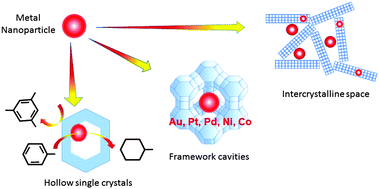Perspectives on zeolite-encapsulated metal nanoparticles and their applications in catalysis
Abstract
Microporous cavities and channels of zeolites frameworks have been used for decades for the encapsulation of cations, complexes and metals. In the particular case of metals, nanoparticles are usually formed after post-synthesis modifications such as ion-exchange or wetness impregnation. Tough encapsulation can provide a strict control of the nanoparticle size as well as a limitation of aggregation at high temperature; encapsulated nanoparticles are often hardly accessible due to diffusion limitations of reactants in sub-nanometric micropores. Recent developments in zeolite synthesis have offered a new class of materials with hierarchical structures or unusual morphologies in which the mean diffusion path is considerably reduced. Those zeolites with inter-crystalline and/or intra-crystalline mesopore systems are particularly adapted for supporting nanoparticles both in microporous cavities of the framework and in mesoporous channels. More sophisticated architectures such as yolk/core–shell materials, in which nanoparticles are protected against poisoning or sintering by a thin zeolite shell, are particularly attractive. In contrast to nanometric intrinsic cavities of zeolite frameworks, a large internal void is available for chemical reactions and such catalysts can be considered as nanoreactors in which the reaction is essentially governed by the permeability of the shell. This review focuses on the most recent progress as well as perspectives in the design of zeolite-containing metal nanoparticles, which differ from traditional materials by the originality of the synthesis method or the morphology of the support.

- This article is part of the themed collection: The Creative World of Porous Materials

 Please wait while we load your content...
Please wait while we load your content...